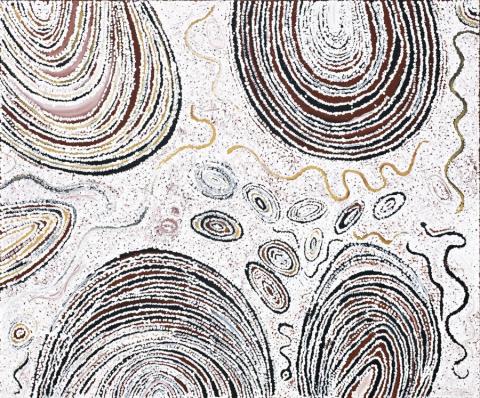GUNAMBALAYI - TRAVELS OF THE BLACK SNAKE, 2004
BILLY THOMAS JOONGOORRA
natural earth pigments and synthetic binder on canvas
150.0 x 180.0 cm
inscribed verso: Red Rock Art cat. KP1988a
Red Rock Art, Kununurra
Private collection, Western Australia
After a long career working as a stockman and police tracker, in 1995 senior law man Billy Thomas expressed his desire to paint. Born near the remote community of Billiluna in Western Australia, his connection to the land has proven symbiotic to his success as an artist. ‘It was while droving cattle on the Canning Stock Route that he first met Rover Thomas. They went on to work together and settle in the Kimberley, both of them finding fame later in life as artists.’1 Following a number of successful exhibitions in Melbourne, Billy Thomas has emerged as one of the leading lights of the next generation of Kimberley artists, displaying a mastery of form and tone so deftly displayed here in Gunambalayi - Travels of the Black Snake.
Painted in the rhythmic style which typifies Billy Thomas’ later work, Gunambalayi - Travels of the Black Snake is significant for being one of only three paintings of this size known to have been produced by the artist. The ground of dusty pinks, greys and browns appears to hum from beneath the veil of white daubed ochre. The stippled cadences simultaneously reveal and conceal Thomas’ sacred references. Land formations and snake trails rise to the surface only to be obscured by the artist’s hand.
The certificate of authenticity from Red Rock Art Gallery describes the subject matter of the painting as: ‘The artist’s totem is the black snake (Gunambalayi); Thomas often paints the travels of this snake in the dreamtime and in the making of the land. In this work, he shows country west of Balgo in the Great Sandy Desert where the black snake travelled looking for children. This work shows Giningingill Country and depicts sandhills that were made by Gunambalayi and is where he still lives today. In the centre of the work are small waterholes, where good water can be found all year round. The lines throughout the work are the snake’s body and the path he travelled in the dreamtime.’
1. Yiwarra Kuju: The Canning Stock Route, National Museum of Australia, Canberra, 2010, p. 212
